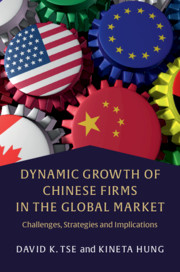Book contents
- Dynamic Growth of Chinese Firms in the Global Market
- Dynamic Growth of Chinese Firms in the Global Market
- Copyright page
- Contents
- Figures
- Tables
- 1 Introduction
- 2 China’s Economic Rise and Global Footprints of Chinese Firms
- 3 Globalisation of Chinese Firms Using Existing Paradigms
- 4 Globalisation of Chinese Firms Using New Paradigms
- 5 Challenges and Failures
- 6 Product Images and Market Acceptance of Chinese-Made Products
- 7 Corporate Social Responsibility
- 8 Managing National Image
- 9 China’s Technological Competence, Trade Relations, and Economic Co-operation
- 10 Holistic Conclusion through a Futuristic Lens
- Index
- References
1 - Introduction
Published online by Cambridge University Press: 05 February 2020
- Dynamic Growth of Chinese Firms in the Global Market
- Dynamic Growth of Chinese Firms in the Global Market
- Copyright page
- Contents
- Figures
- Tables
- 1 Introduction
- 2 China’s Economic Rise and Global Footprints of Chinese Firms
- 3 Globalisation of Chinese Firms Using Existing Paradigms
- 4 Globalisation of Chinese Firms Using New Paradigms
- 5 Challenges and Failures
- 6 Product Images and Market Acceptance of Chinese-Made Products
- 7 Corporate Social Responsibility
- 8 Managing National Image
- 9 China’s Technological Competence, Trade Relations, and Economic Co-operation
- 10 Holistic Conclusion through a Futuristic Lens
- Index
- References
Summary
This chapter provides an overview of the contents and organisation of the book. It begins by tracing China’s economic reform that took place forty years ago as well as its ensuing economic growth and success that gave rise to modern Chinese firms. As firms such as Lenovo, Alibaba, Citic, and Tencent prosper in this socio-economic environment and gain prominence in the corporate world, researchers are beginning to recognise the contributions of emerging market multinational corporations. The chapter then discusses exemplary Chinese firms as game changers in international business. The chapter ends by outlining the organisation of the book, including the details on the four sections, and its targeted audience.
Keywords
- Type
- Chapter
- Information
- Dynamic Growth of Chinese Firms in the Global MarketChallenges, Strategies and Implications, pp. 1 - 13Publisher: Cambridge University PressPrint publication year: 2020



